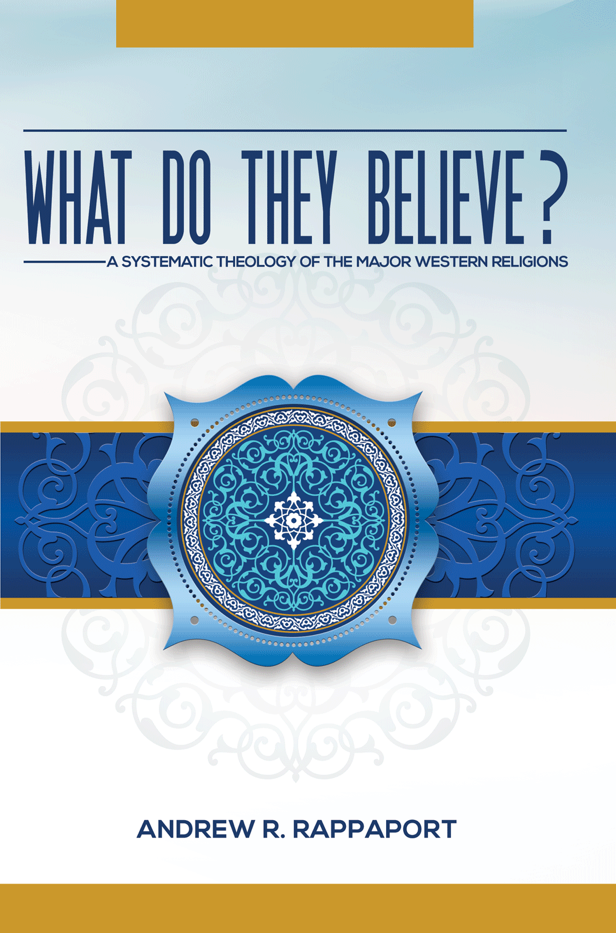Who is Andrew Rappaport?
Andrew Rappaport is the founder and president of Striving for Eternity Ministries which, according to its website, is a “Christ-centered ministry focused on equipping people for eternity by assisting Christians to have an eternal perspective on life.” He is a Bible teacher, conference speaker, and former pastor. In addition to the self-published What Do They Believe?, he has authored several bible studies. Rappaport holds a Bachelor of Computer Science Degree from Monmouth University and a Masters of Theological Studies from Calvary Baptist Theological Seminary.
Rappaport’s Assumptions and the Book’s Purpose
Rapport writes from the perspective of a pre-millennial, inerrantist, quasi-Calvinistic Baptist. His purpose in writing What Do They Believe? A Systematic Theology of the Major Western Religions (the book) is to help Christians engage in the Study of World Religions and Cults. The reasons for such study, according to Rappaport, are five-fold: (1) to know what is believed in order to defend against false doctrines, (2) to recognize the deception that many people are under and seek to set them free with the gospel, (3) to protect against become deceived oneself, (4) to protect one’s family and friends from false religions and cults, and (5) to know the truth.[1] According to Rappaport, “Most religions have groups of cults that splinter from the main religion.”[2] In the book he identifies and examines the beliefs of five cults that splintered from Christianity: Judaism, Roman Catholicism, Islam, Mormonism, and the Jehovah’s Witnesses.
A Summary
Rappaport begins his book by identifying five traits which are typically shared by cults: scripture twisting, authoritarianism, exclusivism, isolationism, and endangerment. The Christian cults identified by Rapport in the book exhibit many of these traits, and, furthermore, exhibit unbiblical views of basic Christian doctrines. In the book, Rappaport systematically identifies and reviews these errant views. He organizes his review of each cult into an examination of what they believe about the authority of scripture, the (Trinitarian) nature of God, the Deity of Jesus Christ, the spiritual condition of man with regards to sin, salvation, and the eternal state. The book closes with a short exposition of what Christianity believes about these things. The sources Rappaport uses to make his review these of cultic beliefs come from the cults themselves. To support his identification of cultic beliefs Rappaport consulted documents considered authoritative by the various cults being reviewed.[3]
Analysis and Evaluation
The book is by no means an academic one. It contains only seven footnotes which refer to but four sources. The reader is dependent on Rappaport’s assertions alone to support a number of statements of fact.[4] Two of the cults identified, Judaism and Islam, are not Western but Eastern religions. There are a number of typographical errors in the self-published work; however, none of them obscure the author’s meaning or intent. The book is light on prose, given that it is a systematic theology, and heavy on direct quotations for cultic sources. For this reason, it is a dry read. At the same time, it is a rewarding read because it imparts a good deal of important knowledge in only 194 pages.
The book is very orderly; a chapter is dedicated to each cult. In addition to detailing the beliefs of each cult, using their own materials, and examining how they conflict with biblical truth, Rapparort provides a short history of the development of each one. After reading the book, the reader should have a clear, basic understanding of the false doctrines espoused by each cult. Readers completely unfamiliar with the doctrines taught by cults may be stunned to see just how far from the Bible these splinter groups have strayed. For those Christians interested in evangelizing cults but without much knowledge of what the various cults believe, the book is a great starting resource. Such readers should keep in mind, however, that they may come away with a better understanding of a certain cult than some of its own nominal adherents. While it’s important to know what cultists believe, it’s even more important to know what Christians should believe. A nominal Christian is no better than a nominal cultist. Thus, Rappaport’s inclusion of a short systematic statement of Christian theology at the close of the book was wise.
[Book Reviewed by Seth Dun]
*Please note that the preceding is my personal opinion. It is not necessarily the opinion of any entity by which I am employed, any church at which I am a member, any church which I attend, or the educational institution at which I am enrolled. Any copyrighted material displayed or referenced is done under the doctrine of fair use.
Bibliography
Rapport, A. (2015). What Do They Beleive? A Systematic Theology of Major World Religions. Striving For Eternity Ministries.
[1] (Rapport, 2015) p.1
[2] Ibid p.2
[3] Rappaort is ethnically Jewish so he is himself an authority of Jewish beliefs.
[4] I study cults myself, in a formal academic setting, and all of Rappaort’s assertions seem accurate according to what I’ve studied.












